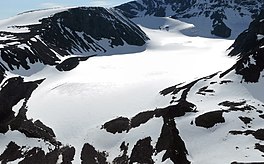| Storglaciären | |
|---|---|
 Overview of Storglaciären, June 2014 Overview of Storglaciären, June 2014 | |
| Type | Polythermal subarctic-alpine valley glacier |
| Location | Kiruna Municipality, Sweden |
| Coordinates | 67°54′10″N 18°34′00″E / 67.90278°N 18.56667°E / 67.90278; 18.56667 |
| Area | 3.1 km (1.2 sq mi) |
| Length | 3.5 km (2.2 mi) |
| Thickness | Average: 93 m (305 ft) Maximum: 255 m (837 ft) |
| Status | Retreating since 1910 |
Storglaciären (Swedish for The Great Glacier) is a glacier in Tarfala Valley in the Scandinavian Mountains of Kiruna Municipality, Sweden. The glacier is classified as polythermal having both cold and warm bottom temperatures. It was on Storglaciären that the first glacier mass balance research program began (immediately after World War II), which continues to the present day; this is the longest continuous study of its type in the world. Storglaciären has had a cumulative negative mass balance of -17 m between 1946 and 2006. The program began monitoring the Rabots Glaciär in 1982, Riukojietna in 1985, and Mårmaglaciären in 1988. All three of these glaciers have had a strong negative mass balance since monitoring began.
For the purpose of studying Storglaciären and nearby glaciers, Stockholm University operates the Tarfala research station in the Kebnekaise region of northern Sweden.
 Panorama taken from ca. 1300-1400 meters above the sea level.
Panorama taken from ca. 1300-1400 meters above the sea level.
See also
References
- ^ Holmlund, Per (15 January 2007). "Tarfala in numbers". Department of Physical Geography and Quaternary Geology. Archived from the original on 4 March 2016. Retrieved 21 March 2012.
- "Storglaciären". Stockholm University. 9 February 2003. Archived from the original on 9 July 2007. Retrieved 27 June 2009.
This article about a glacier in Sweden is a stub. You can help Misplaced Pages by expanding it. |
This article about a location in Norrbotten County, Sweden is a stub. You can help Misplaced Pages by expanding it. |